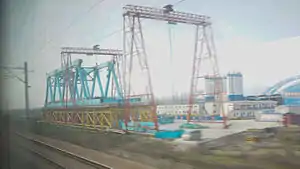Nantong–Shanghai railway
Nantong–Shanghai railway, abbreviated as Tonghu railway (Chinese: 通沪铁路; pinyin: Tōng-Hù tiělù, "Hu" and "Tong" being the abbreviations for Shanghai and Nantong, respectively) is a railway in China's Yangtze River Delta area, connecting Shanghai, the region's main city located south of the Yangtze, with Nantong in Jiangsu province, north of the river.
| Hutong Railway | |||||||||||||||||||||||||||||||||||||||||||||||||||||||||||||||||||||||||||||||||||||||||||||||||||||||||||||||||||||||||||||||||||||||||||||||||||||||||||||||||||||||||||||||||||||||||||||||||||||||||||||||||
|---|---|---|---|---|---|---|---|---|---|---|---|---|---|---|---|---|---|---|---|---|---|---|---|---|---|---|---|---|---|---|---|---|---|---|---|---|---|---|---|---|---|---|---|---|---|---|---|---|---|---|---|---|---|---|---|---|---|---|---|---|---|---|---|---|---|---|---|---|---|---|---|---|---|---|---|---|---|---|---|---|---|---|---|---|---|---|---|---|---|---|---|---|---|---|---|---|---|---|---|---|---|---|---|---|---|---|---|---|---|---|---|---|---|---|---|---|---|---|---|---|---|---|---|---|---|---|---|---|---|---|---|---|---|---|---|---|---|---|---|---|---|---|---|---|---|---|---|---|---|---|---|---|---|---|---|---|---|---|---|---|---|---|---|---|---|---|---|---|---|---|---|---|---|---|---|---|---|---|---|---|---|---|---|---|---|---|---|---|---|---|---|---|---|---|---|---|---|---|---|---|---|---|---|---|---|---|---|---|---|
 Hutong Yangtze River Bridge under construction, March 2016 | |||||||||||||||||||||||||||||||||||||||||||||||||||||||||||||||||||||||||||||||||||||||||||||||||||||||||||||||||||||||||||||||||||||||||||||||||||||||||||||||||||||||||||||||||||||||||||||||||||||||||||||||||
| Overview | |||||||||||||||||||||||||||||||||||||||||||||||||||||||||||||||||||||||||||||||||||||||||||||||||||||||||||||||||||||||||||||||||||||||||||||||||||||||||||||||||||||||||||||||||||||||||||||||||||||||||||||||||
| Termini | Pingdong Huangdu | ||||||||||||||||||||||||||||||||||||||||||||||||||||||||||||||||||||||||||||||||||||||||||||||||||||||||||||||||||||||||||||||||||||||||||||||||||||||||||||||||||||||||||||||||||||||||||||||||||||||||||||||||
| Stations | 9 | ||||||||||||||||||||||||||||||||||||||||||||||||||||||||||||||||||||||||||||||||||||||||||||||||||||||||||||||||||||||||||||||||||||||||||||||||||||||||||||||||||||||||||||||||||||||||||||||||||||||||||||||||
| Service | |||||||||||||||||||||||||||||||||||||||||||||||||||||||||||||||||||||||||||||||||||||||||||||||||||||||||||||||||||||||||||||||||||||||||||||||||||||||||||||||||||||||||||||||||||||||||||||||||||||||||||||||||
| Type | High-speed rail Heavy rail | ||||||||||||||||||||||||||||||||||||||||||||||||||||||||||||||||||||||||||||||||||||||||||||||||||||||||||||||||||||||||||||||||||||||||||||||||||||||||||||||||||||||||||||||||||||||||||||||||||||||||||||||||
| Technical | |||||||||||||||||||||||||||||||||||||||||||||||||||||||||||||||||||||||||||||||||||||||||||||||||||||||||||||||||||||||||||||||||||||||||||||||||||||||||||||||||||||||||||||||||||||||||||||||||||||||||||||||||
| Line length | 137.28 km (85.30 mi) | ||||||||||||||||||||||||||||||||||||||||||||||||||||||||||||||||||||||||||||||||||||||||||||||||||||||||||||||||||||||||||||||||||||||||||||||||||||||||||||||||||||||||||||||||||||||||||||||||||||||||||||||||
| Number of tracks | 2 | ||||||||||||||||||||||||||||||||||||||||||||||||||||||||||||||||||||||||||||||||||||||||||||||||||||||||||||||||||||||||||||||||||||||||||||||||||||||||||||||||||||||||||||||||||||||||||||||||||||||||||||||||
| Track gauge | 1,435 mm (4 ft 8 1⁄2 in) standard gauge | ||||||||||||||||||||||||||||||||||||||||||||||||||||||||||||||||||||||||||||||||||||||||||||||||||||||||||||||||||||||||||||||||||||||||||||||||||||||||||||||||||||||||||||||||||||||||||||||||||||||||||||||||
| Operating speed | 200 km/h (120 mph) | ||||||||||||||||||||||||||||||||||||||||||||||||||||||||||||||||||||||||||||||||||||||||||||||||||||||||||||||||||||||||||||||||||||||||||||||||||||||||||||||||||||||||||||||||||||||||||||||||||||||||||||||||
| Signalling | Automatic block signaling | ||||||||||||||||||||||||||||||||||||||||||||||||||||||||||||||||||||||||||||||||||||||||||||||||||||||||||||||||||||||||||||||||||||||||||||||||||||||||||||||||||||||||||||||||||||||||||||||||||||||||||||||||
| Maximum incline | 0.6% | ||||||||||||||||||||||||||||||||||||||||||||||||||||||||||||||||||||||||||||||||||||||||||||||||||||||||||||||||||||||||||||||||||||||||||||||||||||||||||||||||||||||||||||||||||||||||||||||||||||||||||||||||
| |||||||||||||||||||||||||||||||||||||||||||||||||||||||||||||||||||||||||||||||||||||||||||||||||||||||||||||||||||||||||||||||||||||||||||||||||||||||||||||||||||||||||||||||||||||||||||||||||||||||||||||||||
The railway is 143 km in length and traverses several county-level cities in Suzhou Municipality of Jiangsu along the south bank of the Yangtze including Zhangjiagang, Changshu and Taicang.[1][2] The railway is also called the Shanghai–Suzhou–Nantong railway or the Husutong railway. Initially proposed as the Shanghai–Nantong railway (Abbreviated as Hutong railway),[3] construction works began in March 2014, and was expected to take five and a half years.[4] The railway entered operations on July 1, 2020.[1][2] The railway is designed to accommodate maximum train speeds of 200 km/h[4] and has reduced train travel time from Nantong to Shanghai to just over one hour.[4]
Route
The railway includes 137 km of new tracks, from Pingdong Station (平东站) on the Nanjing–Qidong railway northwest of downtown Nantong to Huangdu railway station on the Beijing–Shanghai railway, in the northwestern part of Shanghai City. Anting being within 20 km of Shanghai railway station, the total railway distance from Nantong to Shanghai is under 160 km.
The railway crosses the Yangtze River over the new Hutong Yangtze River Bridge between Nantong and Zhangjiagang, a double-deck bridge with a 4-track railway on the lower deck and a 6-lane roadway on the upper deck. The bridge is the world's longest span (1092 metres) cable-stayed road-rail bridge with the highest (325 metres) piers of a cable-stayed road-rail bridge.[5] The bridge is the easternmost railway crossing of the Yangtze. Previously, the only railway crossing in the Yangtze Delta region was a freight-only rail ferry on the Xinyi–Changxing railway, between Jingjiang and Jiangyin, some 30 km upstream. The closest railway bridge is the Nanjing Yangtze River Bridge, over 200 km upstream. The new bridge thus greatly improves the railway connections between the Central Jiangsu (the region north of the Yangtze) and the Jiangnan, in particular Shanghai.
On its way between the new bridge and Anting, the railway has brought rail service for the first time to prosperous communities on the southern bank of the Yangtze such as Zhangjiagang, Changshu, and Taicang which had no railway connection. [4]
Notes
- (Chinese) 林小昭, "沪苏通铁路今开通,上海大都市圈迎加快发展新契机" 第一财经 2020-07-01
- (Chinese) "沪苏通铁路开通!江苏南通正式加入长三角1小时经济圈" 央视新闻 2020-07-01
- "沪通铁路改名为通沪铁路 业内:或与铁路命名方式有关". 扬子晚报. 2020-04-14.
- "沪通铁路2013年正式开建 南通到上海仅需一小时" [Construction work on the Hu-Tong Railway will officially start in 2013. It will take just an hour to travel from Nantong to Shanghai] (in Chinese). December 24, 2012.
- Lin Kai (1 March 2014). "Work starts on the dual-use Shanghai-Taiwan Yangtze River". Xinhuanet.